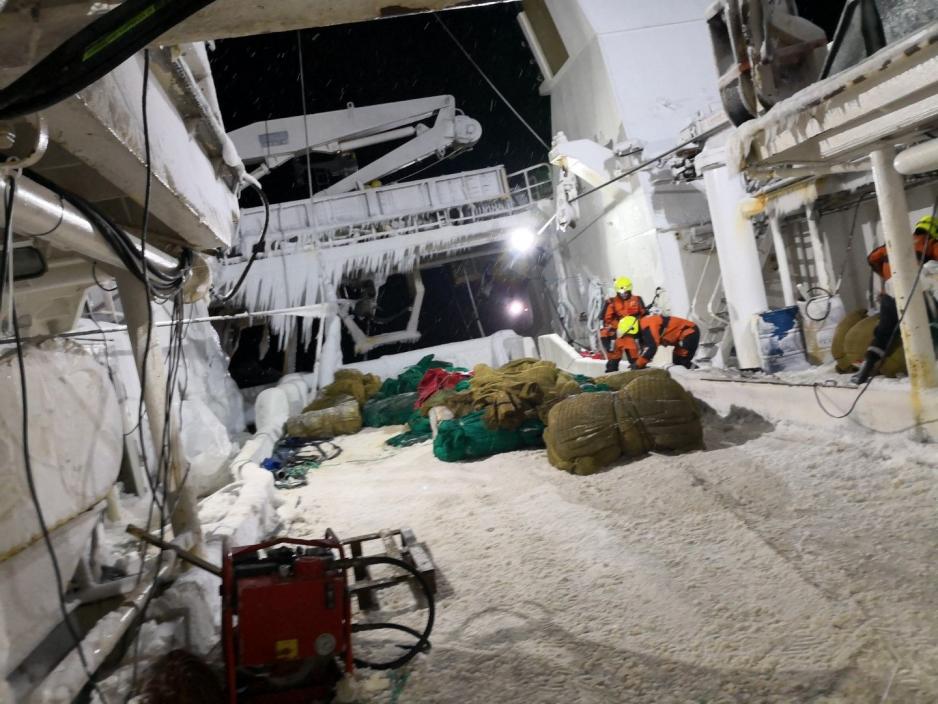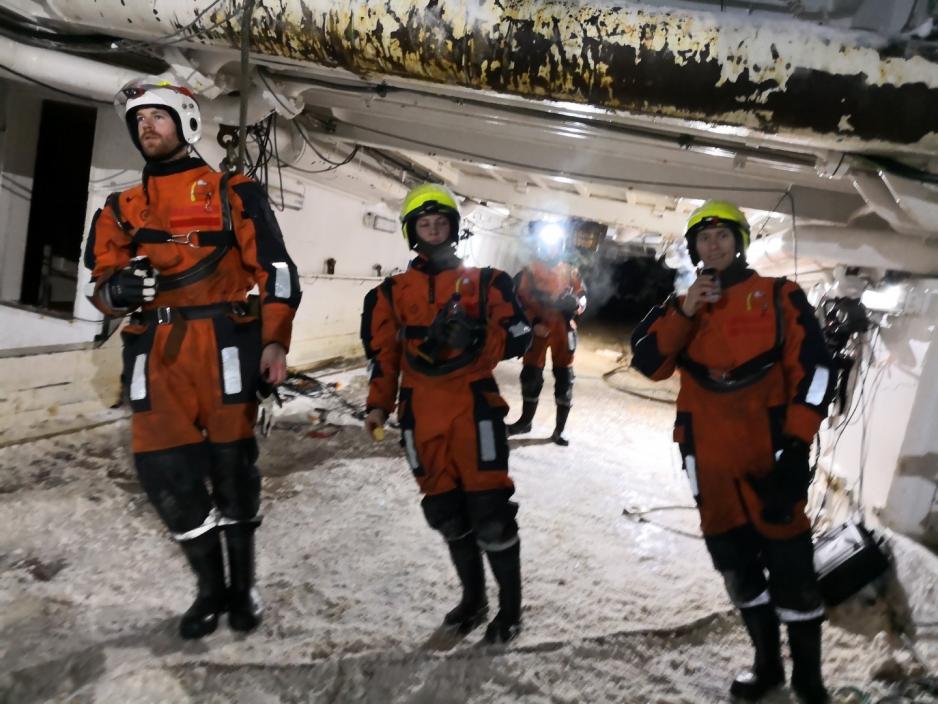Svalbard: Preparing Extreme Pumping Operation Using Small Boats

The diesel onboard the ‘Northguider’ vessel that recently ran aground on Svalbard is to be offloaded using smaller boats. The Coast Guard prepares an extreme operation.
The KV Svalbard coast guard vessel has brought onboard three rib boats and 30 plastic tanks holding 1,000 litres each. It is currently steaming towards the Hinlopen Strait on Svalbard, where the ‘Northguider’ vessel has run aground.
To be emptied using small boats
The plan is for each of the three small boats, with their hardshell hulls, are to transport two tanks at the time, pump diesel from the shipwrecked vessel onto the tanks, return to KV Svalbard and then offload the diesel to the Coast Guard vessel’s fuel tanks.
- The KV Svalbard can hold around 600,000 liters, which is reportedly twice the amount the ‘Northguider’ is holding; it allegedly holds some 320,000 liters, says Steve Olsen, Deputy Commander of the Coast Guard, to High North News.
160 return trips
If this operation succeeds and the small boat operators manage to collect 2,000 liters each trip, the three boats have to conduct altogether a total of 160 trips between the Coast Guard vessel and the ‘Northguider’.
It is impossible so far to say anything about how long time each trip will require. That will depend on weather and wind conditions, on the darkness and the ice that has started to form on the shipwrecked vessel.
- This is obviously a very demanding assignment. Our chip cannot be closer than a minimum of 100 meters to the ‘Northguider’, says Steve Olsen.
- We are good at improvising
- This is not exactly something we will practice at our regular drills, however, our crew is well trained in operating under extreme conditions, they are trained in operating the rib boats and we are fully committed to doing what we can. We realize that there may be some improvising, but we are good at that, he says to HNN.
At present, it appears that the weather will be tolerable from the time when KV Svalbard arrives at the site Tuesday night, and through most of Wednesday. After that, the forecast is less secure.
Olsen emphasizes that the Coast Guard’s role in this operation is solely to support the Coastal Administration’s attempt to avoid a disastrous oil spill in the area.
Coastal Administration’s assignment
- The Coastal Administration ‘owns’ the operation, to put it that way, though salvaging the vessel and paying for the operation is also always the shipowner’s responsibility.
Our assignment is solely for the Coastal Administration, and the shipowner has hired the three rib boats, the tanks and the pumping equipment. The KV Svalbard is generally not equipped with emergency offloading gear, unlike the two other ship classes of the Coast Guard, Deputy Commander Steve Olsen of the Coast Guard says to HNN.

Arne Birkeland, Managing Director of the Opelio AS shipowners, who own the ‘Northguider’ vessel, describes the planned salvaging operation with the KV Svalbard as an emergency solution. However, he says, it is the best option available under the current circumstances.
- All in all, this appears to be the fastest way in which we can empty the diesel tanks.
- A commercial actor would also struggle to reach it. We just have to make the best with what we’ve got, he adds.
The emptying of the 300,000 liters of marine diesel onboard the ‘Northguider’ appears likely to start tonight (Tuesday night), when the KV Svalbard is expected to arrive at the prawn trawler.
Demanding conditions
The operation is expected to be extensive and demanding, even with the weather appears to offer a window of opportunity during the night and also the early hours of Wednesday. Not only is it dark and in the middle of the night when the KV Svalbard arrives, the crew will also have to prepare to work in temperatures as low as 15 or even 20 below zero Celsius.
- Well, this will probably not be quite a walk in the park, Birkeland says, before adding that there will be a total of 73 people in operation when the salvaging operation is scheduled to start.
- There are also polar bears, which our people see all the time, so we must have watchmen for that too, he adds.
Apparently steadily placed
- Is there any danger that the ‘Northguider’ will sink?
- No, she will not. In that case, it will not sink more than one meter, because the shore slope is some 70-80 meters further out, the managing director says.
- We don’t quite know how hard the ice may hit, but the trawler has run solidly aground and that is beneficial, he says.
- The most important thing, Birkeland says, is to empty the trawler of three hundred thousand liters of marine diesel. Whether the KV Svalbard will also succeed in pulling the trawler off ground after that, remains to be seen. If it does not succeed, the trawler may end up stranded for months before it can be removed.
- Of course, we do not want hat. We want it out of there as soon as possible. However, this also has to do with HES (health, environment, safety) considerations, Birkeland says.
Several insecurity factors
- The challenges related to the salvaging of the ‘Northguider’ are extensive than many realise, Tor Husjord of the northern maritime forum (MFN) says to High North News.
- At present, it appears the ‘Northguider’ is placed on a sand bank. It may rest comfortably there, however, if the weather gets worse, things may change, he warns.
The Maritime Northern Forum (MFN) is an interest organization gathering the whole Norwegian maritime industry and engaging more than 700 members nationwide. Husjord, who is Managing Director of its northern office, describes the salvaging operation as a race against the watch.
- There are very, very many challenges related to an operation like this because of its complexity, he elaborates.
If the KV Svalbard, Norway’s largest coast guard vessel, were not to succeed with its operation, renting another salvaging vessel might be necessary.
Requires specialized vessel
An important precondition in that case would be for this vessel to have the appropriate ice classification to operate in the demanding conditions of the Hinlopen Strait. The fjord is well known for strong currents and is at times covered by ice at this time of year.
There is at present slightly less ice in the area than what was the case a week ago, according to HNN’s sources. However, the sea ice is constantly moving and may bring challenges.
If another towing and salvaging vessel were to be needed, this will probably be coordinated through the professional Dutch salvaging company Ardent, which is already assigned by the ship-owners owning the trawler.
Contributes with expertise
Representatives from Sarex Svalbard, a two-year project coordinated by the MFN, has also assisted in the planning of the salvaging operation.
- We have had two representatives there, though they have now returned from Svalbard, Husjord says.
The two representatives, Andreas Kjøl of the Sea Safety division of the Coastal Administration and Knut Espen Solberg, researcher and High North expert, have both had important roles in the two Sarinor projects about Arctic preparedness and SAR operations.
They hold unique competence in this area, Husjord says.
As for the planned salvaging of the ‘Northguider’, the two have been assigned to the task of contributing with knowledge from the Sarinor projects, which have focused precisely on operations in Arctic waters.
- Through the SAR projects (search and rescue), we have acquired broad competence in the field of rescue operations in the Arctic. It was thus natural to offer our assistance, Husjord says, with his MFN being the coordinator of the Sarinor projects.
This article originally appeared in Norwegian and has been translated by HNN's Elisabeth Bergquist.
